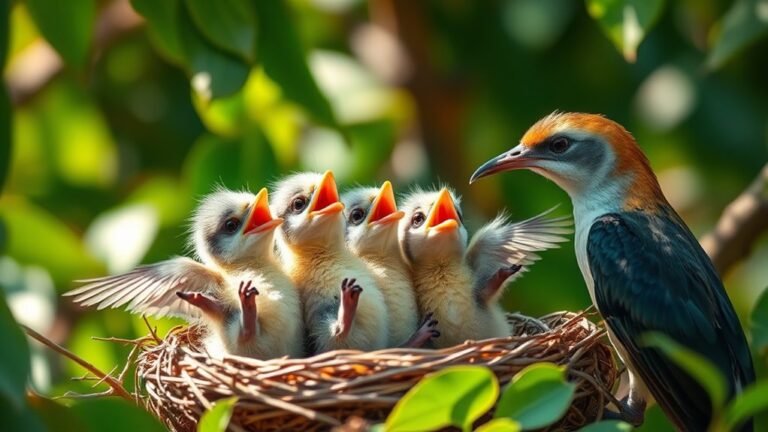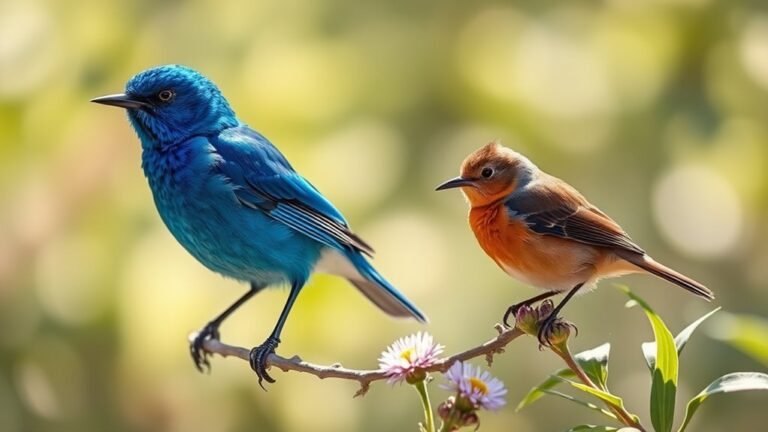What Does Bird Poop Look Like? Signs of Avian Activity
When you see bird droppings, their shapes and sizes can tell you about the bird species. Small songbirds usually leave small, round pellets. In contrast, larger birds like crows produce longer, more elongated waste. The color and texture of these droppings can reflect what the birds eat, such as fruits or seeds. By recognizing these traits, you can learn more about local bird activity and their role in the ecosystem. This knowledge can inspire you to explore the interesting behaviors and habits of birds even further.
Key Takeaways
Bird droppings have different sizes and shapes. Small pellets come from seed-eating birds, while larger birds, like crows, produce elongated droppings.
The color of bird droppings can indicate what they eat. Bright colors often mean birds eat fruits. Darker colors usually stem from seeds or insects.
Texture varies, too. Firm droppings suggest a drier diet, while liquid droppings indicate a diet rich in water.
Smell can also provide clues. Sweet-smelling droppings usually come from fruit-eaters, while strong odors are typical of insect-eating birds.
You can find seed husks, feathers, and insect parts in droppings. These can help identify specific bird species and their feeding habits.
Understanding the Basics: What Bird Poop Looks Like
When you see birds, noting their droppings can help you identify local species. Different birds have distinct droppings based on their diets. Seed-eating birds leave behind small, granular droppings, while insect-eating birds produce more liquid waste. Recognizing these differences can deepen your understanding of bird behavior and habitats.
Bird droppings also benefit the environment. They contain nutrients that help plants grow and aid in nutrient recycling in ecosystems.
By observing droppings, you can learn about the relationship between birds and their surroundings. This awareness can inspire a greater appreciation for birds and encourage you to participate in your local ecological community.
Analyzing Shape and Size: Key Features of Bird Droppings
The shape and size of bird droppings are important for identifying bird species and their diets. Sizes can vary widely. Small songbirds produce tiny, pea-sized droppings.
In contrast, larger birds like crows leave bigger, elongated droppings. The shape also varies by diet. Raptors, which eat meat, have tubular droppings. Herbivorous birds, such as finches, create flatter, round droppings.
Observing these details helps bird watchers spot different species in various areas. By understanding the specific shape and size of droppings, you can connect better with local birds and appreciate their role in the ecosystem.
Color and Texture: What Do They Indicate?
The color and texture of bird droppings can reveal important information about a bird's diet and health. Various colors, from white to dark brown, indicate different types of food. For instance, bright colors may mean the bird eats a lot of fruit, while darker colors often suggest a diet of insects or seeds.
Texture also matters. Liquid droppings usually indicate a diet rich in water-based foods, while firmer droppings suggest that the bird consumes drier items.
Smell and Composition: Insights From Avian Waste
Bird droppings reveal important information about a bird's diet and health. The smell and composition of their waste can show what they eat and how well they process food. For example, droppings from fruit-eating birds often smell sweet, while droppings from insect-eating birds have a stronger, more pungent odor. This difference is due to the varying protein levels in their diets.
Analyzing the waste of birds also helps us understand the health of local ecosystems. By identifying these smells, you can gain insights into bird behavior and contribute to the study of avian ecology in your area.
This knowledge enriches our understanding of nature and the environment we share with these amazing creatures.
Identifying Bird Species: Using Droppings as Clues
Many bird watchers and researchers use droppings to identify bird species. By looking at the shape, size, and color of droppings, you can learn about different birds.
For example, rounded droppings that shine often come from fruit-eating birds, while long droppings might come from insect-eating birds. You can also find seed husks, feathers, or insect parts in the droppings, which can help you identify the species further.
Noticing these details can deepen your appreciation for birds and improve your birdwatching experience. The next time you see bird droppings, remember they offer valuable clues about the birds around you.
Frequently Asked Questions
How Can Bird Droppings Affect Plants and Gardens?
Bird droppings can boost the health of your garden plants. They add nutrients like nitrogen, phosphorus, and potassium. Using them wisely helps plants grow well and supports the ecosystem in your yard.
Are There Health Risks Associated With Bird Poop?
Bird poop can pose health risks primarily through disease transmission. Exposure to pathogens like histoplasmosis and psittacosis can occur from contact with droppings. Therefore, it is important to keep clean and practice good hygiene when dealing with bird feces. This helps protect your health and well-being. Always use gloves and masks when cleaning to minimize risks and keep your environment safe.
How to Clean Bird Poop From Surfaces Effectively?
To clean bird poop effectively, start by identifying the surface material. For most surfaces, use warm, soapy water. Apply the soapy water directly to the area with bird poop and wipe it clean with a cloth. For porous surfaces, use a specialized cleaner to avoid damage and staining. Always rinse the area afterward to remove any residue. This method ensures that your surfaces stay clean and undamaged.
Can Bird Droppings Indicate the Presence of a Nesting Site?
Yes, bird droppings can signal nearby nesting sites. By examining the droppings, you can identify the bird species and their nesting habits. The size, shape, and contents of the droppings provide clues about the birds' activities. If you see droppings in your area, it may mean that birds are nesting close by. This can be an interesting observation for bird watchers and nature enthusiasts.
What Should I Do if I Find a Lot of Bird Droppings?
If you find a lot of bird droppings, follow these steps:
- Identify the characteristics of the droppings to learn about the birds.
- Clean the area safely using gloves and a mask to avoid health risks.
- Document the location and amount of droppings.
- Consider reporting your findings to local wildlife authorities.
Understanding bird droppings can provide insights into bird behavior. Cleaning helps maintain a safe environment, and documenting can help others study wildlife trends.

Ava is a bird enthusiast and nature lover who has spent countless hours observing and learning about the fascinating world of birds. With a passion for sharing her knowledge and inspiring others to appreciate the beauty of birds, Ava writes about her experiences and insights on avianadmirer.com.







